14 Flowers & Plants That Attract Monarch Butterflies (With Pictures)
-
Chris Dinesen Rogers
- Last updated:
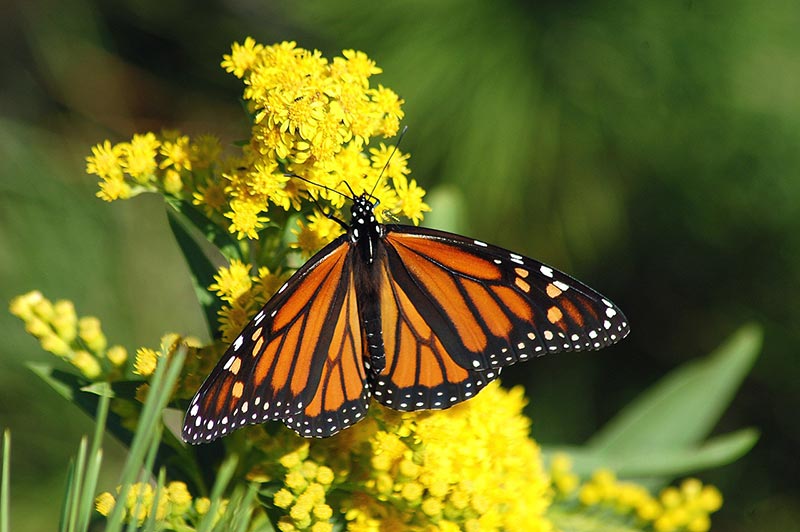
One of the quintessential signs of summer is Monarch Butterflies flitting around flowers in full bloom. Many people view their gardens as sanctuaries for wildlife and other beneficial organisms and fill their yards with equally valuable plants. Birds and butterflies rank high on the list of popular visitors for homeowners. Providing habitat and food is an excellent way to safeguard populations.
Recently, the International Union for Conservation of Nature and Natural Resources (IUCN) reassessed the Migratory Monarch Butterfly as an endangered species due to dwindling numbers. It is a subspecies of the monarch you’ll likely see in your garden. Nevertheless, its population is also declining, making butterfly-friendly plants a wise landscaping plan. Here are 14 to get you started.
The 14 Flowers & Plants That Attract Monarch Butterflies
1. Asters (Aster sp.)
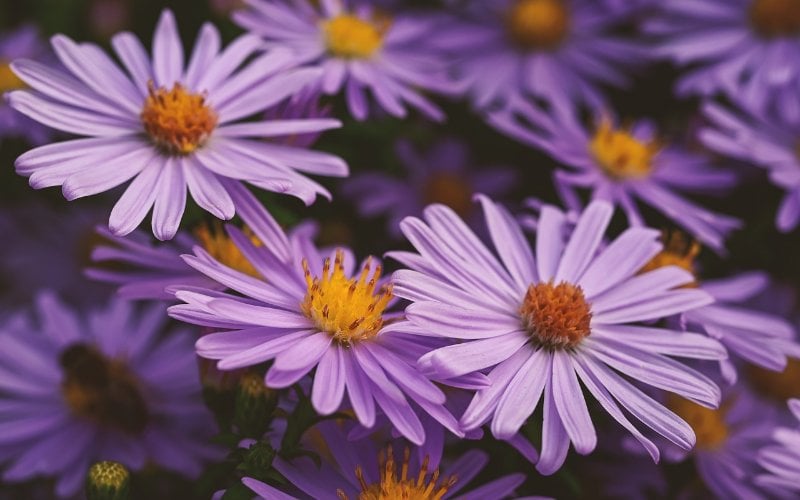
| USDA Hardiness Region: | 3–7 |
| Sun Exposure: | Full sun/partial shade |
| Bloom Time: | Late summer, early fall |
Asters are part of a large and diverse subfamily of plants called Asteroidea. It is the largest, with 23,600 species in 1,620 genera. Popular varieties include the New England Aster and Sky Blue Aster. They will attract butterflies and bees in late summer when the flowers bloom. They’ll also provide shelter for caterpillars in the spring. Gardeners will appreciate these species being deer-resistant.
2. Wild Bergamot (Monarda fistulosa)

| USDA Hardiness Region: | 3–9 |
| Sun Exposure: | Full sun/partial shade |
| Bloom Time: | Mid-summer through early fall |
Wild Bergamot is a beautiful and fragrant flower that will attract pollinators and other wildlife, including hummingbirds. Its scent is pleasant, which may explain its use as a culinary herb and tea. American Indians used it for various medicinal purposes, including as a cough and headache medicine. It is a native plant that grows in dry soils throughout the lower 48 states.
3. Blazing Star (Liatris sp.)
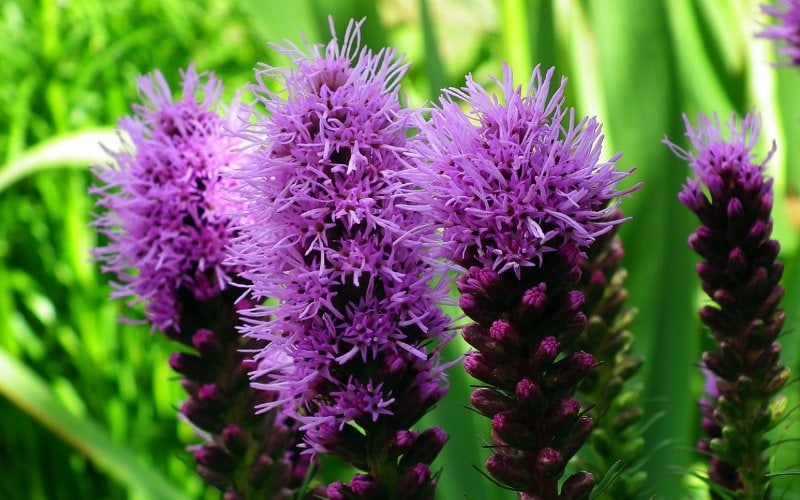
| USDA Hardiness Region: | 3–9 |
| Sun Exposure: | Full sun |
| Bloom Time: | Mid to late summer |
Blazing Star is one of the more gorgeous prairie plants you can add to your landscaping, bringing welcome late-season color to your garden. It prefers dry soils and grasslands where it will thrive. Its bloom time is ideal for providing food for migrating monarchs for their long journey. It’s also a host species for several moths.
4. Blue Vervain (Verbena hastata)

| USDA Hardiness Region: | 3–8 |
| Sun Exposure: | Full sun |
| Bloom Time: | Mid-summer to early fall |
Blue Vervain offers much for people who want to encourage butterflies and other pollinators. Not only is it deer-resistant, but it also will attract hummingbirds and stand in as a host plant for other beneficial insects.
Although it’s a prairie plant, it prefers moist soils, such as you’d find in wet meadows. Its flowers aren’t showy. However, it stays in bloom for a relatively long 2 months.
5. Butterfly Bush (Buddleja davidii)
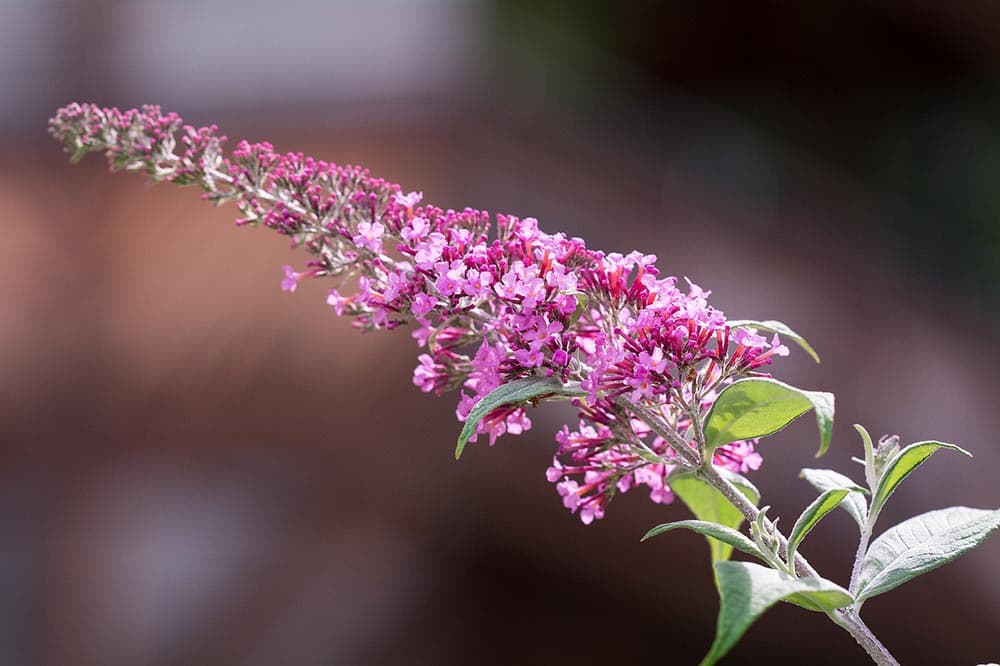
| USDA Hardiness Region: | 5a–9b |
| Sun Exposure: | Full sun/partial shade |
| Bloom Time: | Spring to early fall |
The Butterfly Bush has a lot in common with many of the plants on our list, including its attractive purple blooms. Suffice it to say that it’s also appropriately named. It’s a large shrub, getting 10 feet high with an 8-foot spread. It will make an excellent windbreak while encouraging pollinators and butterflies to visit your garden. The bush is also deer resistant.
6. Butterfly Weed (Asclepias tuberosa)
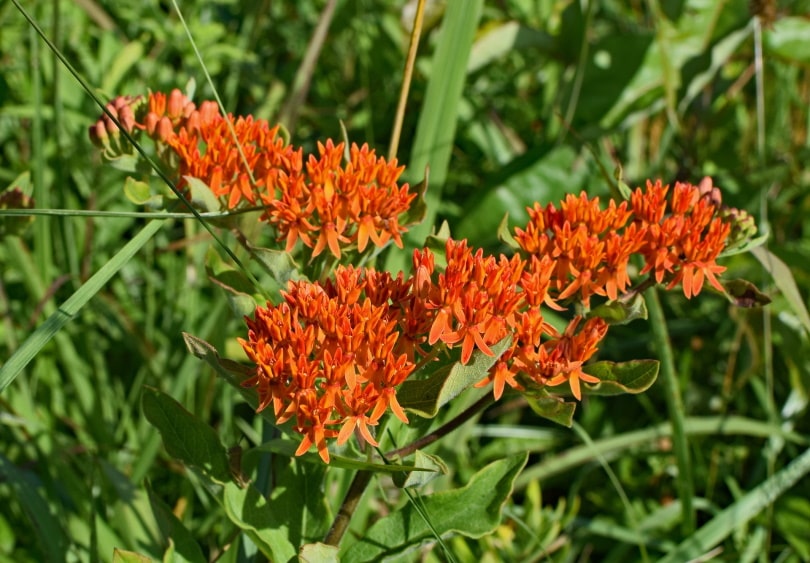
| USDA Hardiness Region: | 3–10 |
| Sun Exposure: | Full sun |
| Bloom Time: | Summer |
Butterfly Weed is another plant that gets its name for a good reason. Its bright orange blooms will create a beautiful focal plant when placed adjacent to the purple flowers on our list. It attracts a wide range of butterflies, including monarchs, for which it is a host plant. It’s a hardy species that will set down a deep taproot when it gets established.
7. Goldenrod (Solidago sp.)
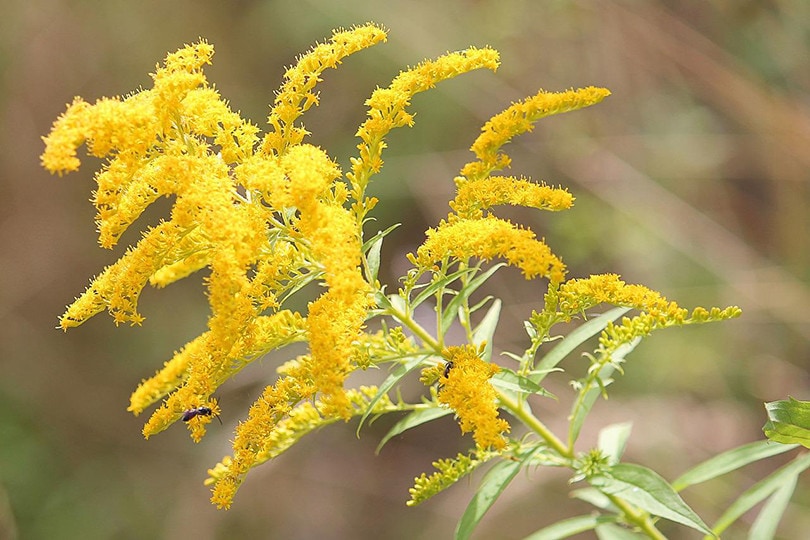
| USDA Hardiness Region: | 5–8 |
| Sun Exposure: | Full sun/partial shade |
| Bloom Time: | Late summer to early fall |
Goldenrod often gets a bad rap as the cause of allergies. The real culprit is ragweed which often grows in the same area and time as this plant. There are 128 species. However, not all of them are welcome in some states.
The plant is hardy and robust, often crowding out other less aggressive species. Nevertheless, goldenrods provide an excellent source of nectar for butterflies.
8. Joe Pye Weed (Eupatorium sp.)

| USDA Hardiness Region: | 3–6 |
| Sun Exposure: | Full sun/partial shade |
| Bloom Time: | Late summer |
Joe Pye Weed is another robust plant that can reach heights up to 6 feet depending on the species. It prefers moist soils in wet meadows and can act as an effective soil anchor on streambanks. It’s a native plant in the eastern part of the country. Like many on our list, it is also a host plant for butterflies. Its fragrant lavender flowers are a surefire draw for monarchs.
9. Lavender Hyssop (Agastache foeniculum)
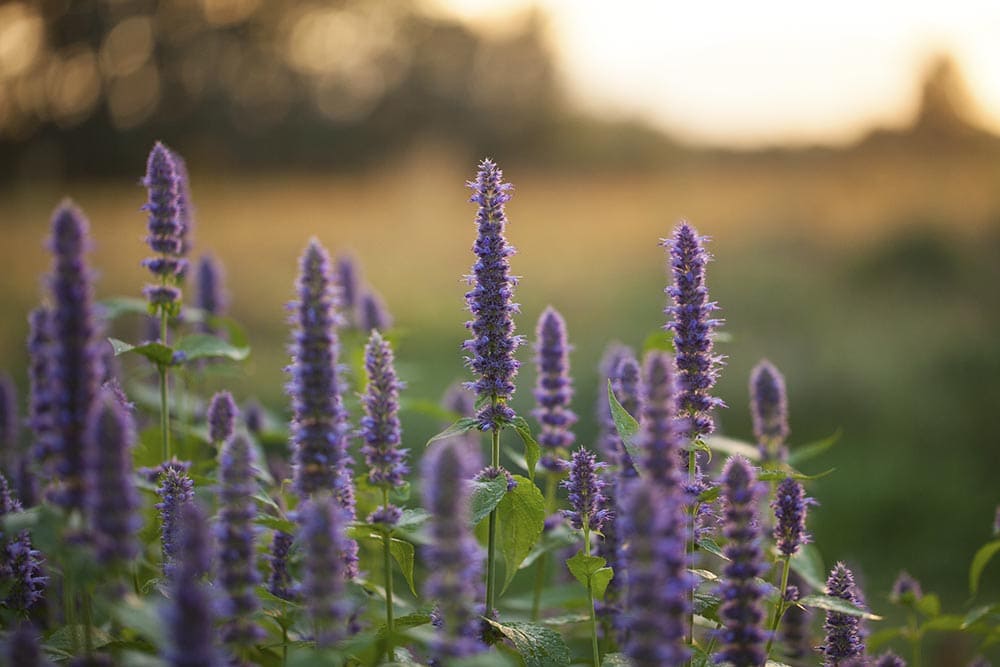
| USDA Hardiness Region: | 2–6 |
| Sun Exposure: | Full sun/partial shade |
| Bloom Time: | Mid-summer to early fall |
Lavender Hyssop is a delightful plant with pretty purple flowers and a pleasant mint-like scent. Like Blue Vervain, its blooms last long. It also attracts hummingbirds while fending off the deer. This plant acts as a host for other butterfly species. Its purple spikes will create a beautiful display in your landscaping and make an eye-catching focal point.
10. Lupine (Lupinus perennis)

| USDA Hardiness Region: | 3–8 |
| Sun Exposure: | Full sun/partial shade |
| Bloom Time: | Late spring to early summer |
The Lupine is a low-growing plant that’s ideal for a spot where you want to create layers in your landscape design. It prefers dry soils that are well-draining. It serves several functions as many of the species on our list.
The plant is native across the eastern United States and south into Texas. It’s rare or even extinct in some parts of its range. Planting it will benefit the species and butterflies.
11. Milkweed (Asclepias sp.)

| USDA Hardiness Region: | 3–8 |
| Sun Exposure: | Full sun/partial shade |
| Bloom Time: | Throughout the summer |
Milkweed is the quintessential monarch plant. If you have these plants in your garden, you will have butterflies—and birds and pollinators. This butterfly also depends upon this genus as host plants. Fortunately, these species are hardy and can thrive in a variety of soil types as long as they are well-draining. They are native to the eastern two-thirds of the country into Canada.
12. Phlox (Phlox sp.)
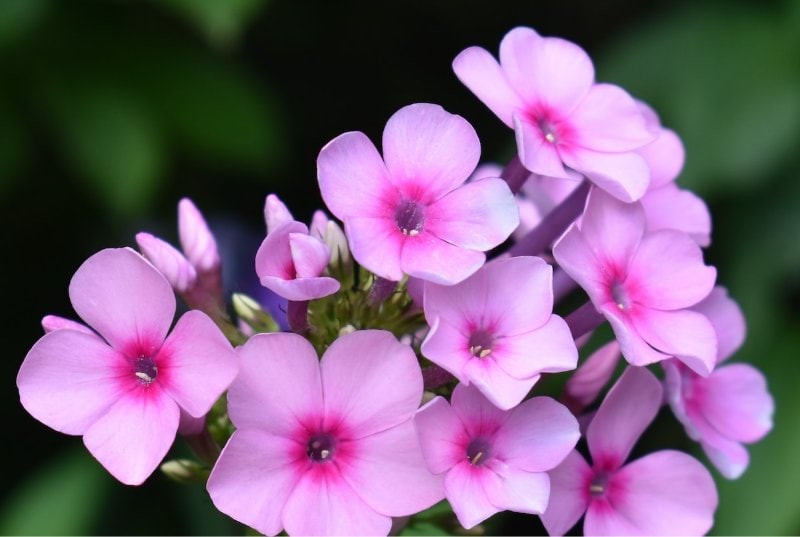
| USDA Hardiness Region: | 3–9 |
| Sun Exposure: | Full sun |
| Bloom Time: | Spring to early summer |
Phlox are lovely spring plants that can ensure you’re taking care of the local monarchs as soon as the weather breaks. They are delicate flowers, yet they are cold-tolerant, judging by their hardiness zones. They will also attract hummingbirds to your garden, providing a vital food source for them when they return in the spring.
13. Purple Coneflower (Echinacea purpurea)
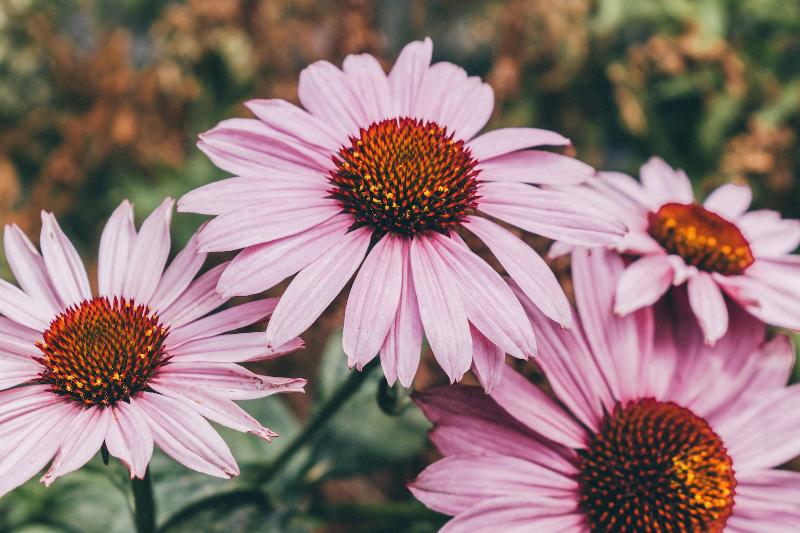
| USDA Hardiness Region: | 4–8 |
| Sun Exposure: | Full sun/partial shade |
| Bloom Time: | Mid to late summer |
Purple Coneflower belongs in any butterfly or bird garden. Many pollinators, including Monarch Butterflies, feed on its rich nectar. The seedheads will also provide a fall and even a winter food source for resident bird populations. Like many prairie species, you won’t find many native plants. Your addition of it to your garden will help ensure future generations can enjoy its beauty.
14. Sunflowers (Multiple genera)

| USDA Hardiness Region: | 3–8 |
| Sun Exposure: | Full sun/partial shade |
| Bloom Time: | Mid to late summer |
Sunflowers are the plants of summer. Their bright yellow color is sure to make anyone smile. You’ll keep the birds happy with their nutritious seeds. The abundant nectar will ensure the butterflies get their share.
Caterpillars will also benefit from you having a few plants in your yard. It’s worth noting that you may get some four-legged visitors, such as deer.
Attracting Butterflies
Butterflies, like any organism, need three things to survive: food, shelter, and water. The plants on our round-up will cover the first two. Big-leafed varieties will provide places for them to rest and get out from under the hot sun. They’ll also take care of the growing caterpillars. We suggest you consider adding a birdbath to your landscaping. It’ll help your feathered friends and the Monarchs.
We recommend planting a variety of species. Of course, milkweed is high on the list, but butterflies need a reliable food source throughout the season, especially those returning or leaving on migration. You should also be careful when using pesticides in your garden. While herbicides target weeds, they can harm more sensitive non-plant species.
Conclusion
Planting butterfly-friendly species is an excellent way to take your gardening to the next level with plants that can help the vulnerable survive. Luckily, many have brightly colored flowers that offer another reason to include a few in your landscaping. It’s hard to beat the satisfaction of helping wildlife thrive in a changing world.
- Migratory monarch butterfly now Endangered – IUCN Red List – Press release | IUCN
- Danaus plexippus (Monarch Butterfly)
- Asteraceae
- Landscape Plants Rated by Deer Resistance (Rutgers NJAES)
- BRIT – Native American Ethnobotany Database
- Gardening With Prairie Plants: How To Create Beautiful Native Landscapes
- Solidago L. | Plants of the World Online | Kew Science
- USDA Plant Hardiness Zone Map
Featured Image Credit: bbarlow, Pixabay
Contents

